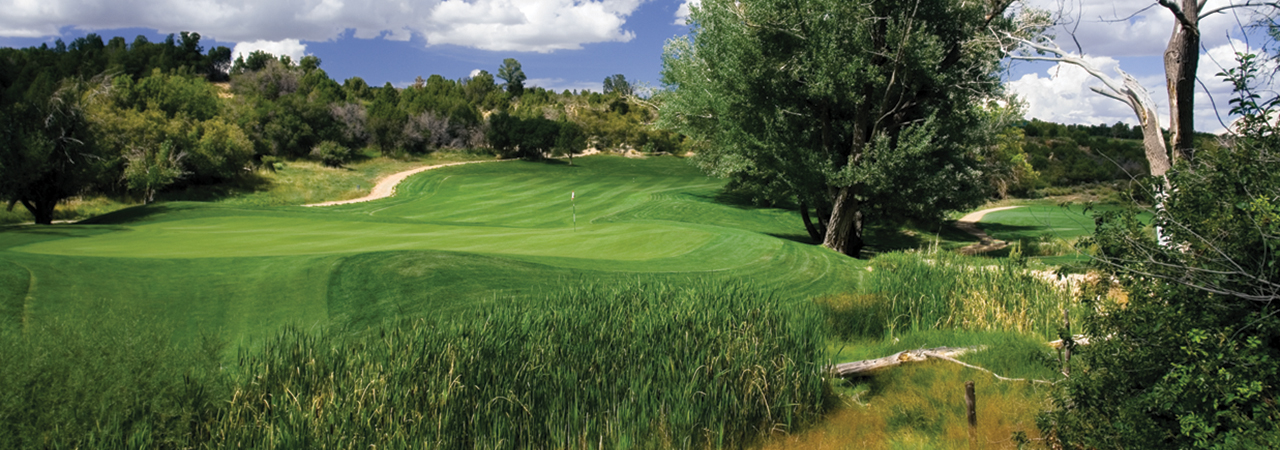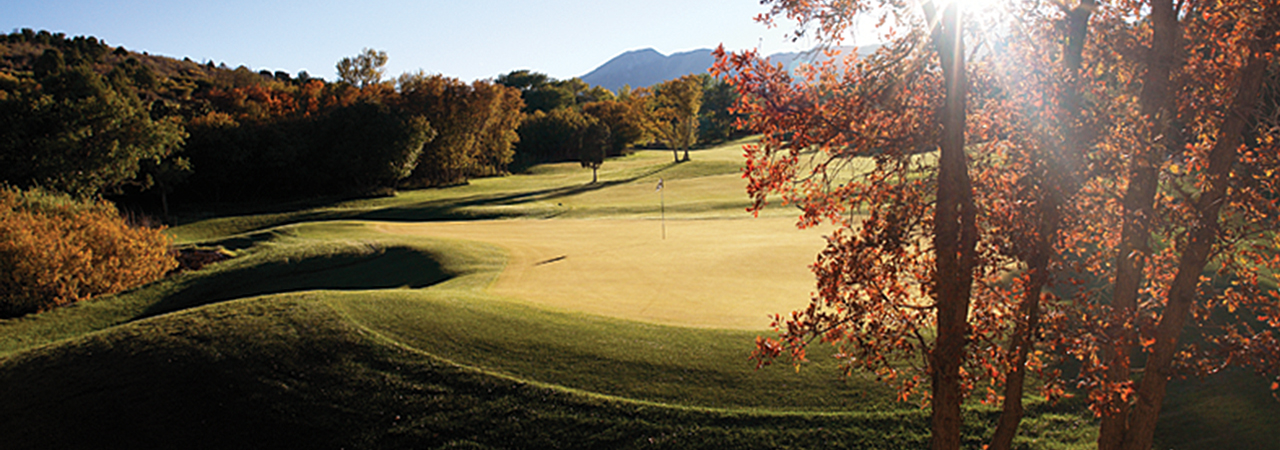Project Description
Monticello golf was worth the drive…and when Golfweek began its listing
of America’s top municipal courses, The Hideout checked in at No. 23
Project Overview
Utah’s “hidden gem,” as it has been called, is located in the Four Corners Region of Southern Utah. At 7,000 feet above sea level, this Alpine course takes advantage of rustic vegetation, dramatic elevation changes, amazing vistas and the relaxing setting of quaint Monticello, Utah. This regulation 6700 yard, 18-hole, par-72 layout is a favorite summer golfing retreat.
The course plays over wooded and rocky hillsides, through pleasant grassy meadows and over and along babbling winding streams. Some holes feature elevation drops greater than eighty feet, even on a single shot. The par-4 No. 4 hole finishes across a dramatic hollow twenty-feet deep previously used to retain water for cattle. Hole Nos. 13 and 14 are back-to-back par-5s which team up with the short 15th to allow a chance to get a birdie or two before encountering the climactic and challenging trio of sixteen, seventeen and eighteen. Hole No. 18 is a risk-and-reward par-4 playing nearly 460 yards to a green guarded by a pond and stone wall.
Construction Background
Construction on The Hiedout Golf Club began in 2000 and continued for 18 months. Earthmoving involved just 200,000 cubic yards, with holes carefully routed in natural glens and across ridges. Construction work totaled $2.8 million, which included a fully automatic irrigation system delivering water to 92 acres of turf. Site obstacles involved naturally running springs, wetlands habitats and logging of forested areas. Through advance cutting of centerlines across the site, the golf architects were able to work with the contractor and governing agencies, such as the Army Corps of Engineers, to work out solutions to sensitive areas of the course that needed to be preserved during construction.
Historical Background
The story of The Hideout begins with Uranium mining. Throughout the 1940s, 1950s and into the 1960s, the quiet town of Monticello in southeastern Utah was home to a large Uranium mill consuming nearly 100 acres. Located right in the heart of town, the hustle and bustle of the mill was the biggest industry in town. Subsidized in part by the U.S. Government for its war effort, the shipments of processed Uranium kept the town alive.
In the early 1960s, golf course architect Arthur Jack Snyder was asked to help layout a golf course. The result was a short 9-hole course that was literally built by the townspeople via a grassroots effort. The irrigation was a simple system built from old refinery pipe from Farmington, New Mexico and the entire set-up was operated much like a co-op.
Snyder never heard much about his efforts, called Blue Mountain Meadows, until some 40 years later when his protégé, Forrest Richardson, fielded a call from an engineer interested in pursuing a golf project. Apparently the town had decided to look into expanding their little nine-hole course. Richardson recalls asking Snyder about if he knew where the town was located. “When I mentioned Monticello, Jack told me matter-of-factly that he had done a course there,” said Richardson. “I was somewhat shocked — I’d never heard him speak about it before.” Richardson learned that Snyder had done the original work as somewhat of a favor to the town, taking only a modest $1500 fee for visiting a few times, doing a routing plan, an irrigation layout and some rough grading plans. The original 9-hole had opened, coincidentally, just after Richardson had been born. “It was truly exciting to think there was a little course that Jack had designed, and that we might get to work on it again,” said Richardson. So, off the two went, to learn what the city had in mind.
What they learned was that Uranium had left Monticello years earlier. During the last 20 years the U.S. Department of Energy (DOE) had been cleaning up the town, removing the mill site and all created in its wake. An enormous ‘depository’ had been built to house the debris collected from the mill site, as well as from throughout town where potentially radioactive soils were removed and forever interred. Although there was speculation that the aftermath of Uranium has caused disease and sickness, nothing was ever proved and the conclusions of many reports were that Monticello was spared by having the mill site largely contained and the tailings mostly buried. The job of the government was to carefully unearth the tailings and all the debris of the milling operations.
As part of the clean-up process, the town was being offered a buyout on its acquisition of the old mill site. Since the land was now under Federal oversight the best use was to return it — once totally clean and free of hazard-to the public. Under directives from the Environmental Protection Agency (EPA), the DOE had to not only clean up the mill site, but also restore the land to a natural condition. In terms of public use, the DOE wanted to find the best use and help the city realize that potential. This is when the idea was born for a golf course expansion.
Because the mill site had been located right across the highway from the old 9-hole golf course, the city felt there might be potential for a 9-hole expansion using the land of the old mill for the new holes. This was even more feasible as a result of the DOE’s commitment to not only help return land to a suitable condition, but also to help restore economic vitality to a location. In Monticello’s case, the long history in mining and processing Uranium had been the town’s mainstay — for the last twenty years there had not been much of an economy at all. Monticello was ready for a boost — perhaps an expanded golf course could help put it on the map.
The only directive of the DOE was that the land was vegetated and protected from erosion. A golf course would certainly accomplish that. Because there was money earmarked to restore and vegetate the land, it was fair game for the city to take the money and use it however they saw fit. The idea for a “new” golf course was on its way to becoming a reality.
The Feasibility Process
Monticello is tucked away in the Four Corners region of southeastern Utah, at the base of Blue Mountain. At 7000 feet elevation, the City is small, but charming. During the summer tourists flock through the town on their way to any one of the many national parks, monuments and tourist areas of this area rich with Native American ruins and geologic wonders such as sandstone cliffs, spires and natural bridges. It is right on the edge of this little town that the Blue Mountain meadows Golf Course rested for more than 40 years.
Eventually Snyder and Richardson were contracted by the town to help determine feasibility and, if a proven idea, to eventually design an expanded 18-hole course. The two went to work collecting data and finding out how the eventual restoration of the mill site needed to be accomplished. In its deal with the Federal Government, the town would be required to restore the old mill land, in the process re-routing a creek through the land and planting the hillsides with vegetation. That last part — the planting of vegetation — was the key to a golf course. When the land was restored the city would receive about $7 million, a bargain compared to how much the federal government would spend if they undertaken the project.
“There were few conditions to the deal,” notes Richardson. “The DOE has found this approach to be a win-win situation. The local community gets to plan and spend the money as it sees fit, in the process creating new parks and areas that they need to make the community a better place to live.” Of course the DOE does not mandate ‘golf course,’ or for that matter any specific improvement to the land. Their focus is simply that the land remain useful to the public and that it be restored to prevent erosion. The EPA was interested in the same end result, with an emphasis on making sure the creek that once flowed through the property was reestablished with native wetlands.
The first step of the team was to work with the city to determine whether an 18-hole course could be supported. Although the little 9-hole had operated for 40 years, it was never maintained to be much more than a out-of-the-way local course, occasionally attracting visitors, but mostly locals. Certainly it was not a ‘destination course’, one that would attract thousands more tourists wanting to play a world class layout. Part of this was in its 9-hole state, and the other rested in Monticello’s ‘hidden’ locale. “Monticello is way off the beaten path, at least in awareness,” notes Richardson. “People travel through the place, but we found they rarely stop unless their gas gauge is near empty of they have to use the restroom.”
The golf architects brought in a full team of experts to work with the city. This included a recreation planner, an engineer, a golf feasibility analyst and a marketing specialist. The goal was not to find a way that a course could be justified, but to appraise the situation objectively and give the city the true picture. The team spent months understanding the traffic counts on the highways going through town, surveying local residents on what recreation needs they would support, and looking at tourism statistics for the region.
The conclusion was reached that Monticello could support a ‘new and improved’ 18-hole course, providing that the following criteria was met: (1) The development cost would need to be less than $6 million, (2) The course would need to be designed to attract its predominant play from outside the area, and (3) There would need to be an extreme push to market the course.
The team’s conclusion was accepted by the city. Monticello had taken the first step to transforming its mill site into a public amenity. Hopefully it would follow that the three criteria could be met under the tight budget.
Site Selection and The Routing Plans
In order to satisfy the three criteria, the golf course architects began their work. A variety of options was explored including using the existing nine holes and adding nine more on the mill site, or scrapping the existing course and building the entire facility on the mill site. The terrain of the old uranium mill proved to be difficult to work due to its steep slopes that were barren of any vegetation. All together there were four routing plans prepared for using the old mill site, each was studied for its probable cost.
But the golf course architects kept coming back to criteria that required an outstanding course that would attract play from outside the region — and be marketable. Although each of the options looked to be doable under the budgets, there was concern about establishing golf on the mill land from a variety of perspectives. Richardson sums up these concerns: “The mill site ultimately needed to be completely re-vegetated and yet a 9-hole expansion only covered a small portion of it. What’s more, much of the little 9-hole course was too short and would need to be significantly altered. And then there was the difficulty of getting golfers across or under the major highway. To all this we had the budget to consider. We asked ourselves how much would really be needed to transform the complete blank mill site into a golf course that would match the Alpine feeling of the community-and meet the criteria in terms of marketability.”
This was when the team began looking outside the box.
As part of their study of routing plans, Snyder and Richardson suggested a fifth alternative. Although not a ‘plan,’ the fifth idea was a bold one: Perhaps the city might look elsewhere to build an entirely new 18-hole course and simply restore the mill site with the minimal re-vegetation required by the DOE and EPA.
At first this was not viewed as a viable plan. After all, how could you accomplish both restoration of the mill site and still have money available to build an entirely new course? But there was interest. At more than one public meeting discussion focused on this new idea as it struck a chord with the locals who knew that the existing course, although beloved, was old and tired — and small. And it became apparent in studying the projected costs for the options to build a course on the mill site that there would be much compromise to the course as a result of restrictions placed by the DOE.
The city began asking more questions to Snyder and Richardson. Finally a breakthrough came through. Local and long-time resident, Rex Jensen, offered a sweet deal. He would give the city enough land to add to the existing course toward the mountain, eliminating the need for the road crossing. His offer would allow the city to concentrate on restoration of the mill land while expanding the course in a more suitable direction.
If adopted, the plan would also contribute to the city’s land holdings — and create a greenbelt of open space that would extend from the old mill site to the National Forest land bordering the town.
The design team was directed to look into the suitability of the new land. Snyder and Richardson went to work immediately, and a new routing plan was created. What is showed was a positive outcome: Not only would the course be more efficient to build, but restoration of the mill site would also be more efficient. It was forecast that, as a result of this new site approach, money could actually be saved. This was accomplished by keeping the design of the course minimal in terms of manufactured land forms. The intention was to create an efficient design that would be reasonable to construct. Earthmoving, landscape material and all specifications were kept to a minimum. With few exceptions, material would simply be pushed from one place to another in order to shape the course into the natural landscape. Best of all, there would be no crossing of the highway and the land being donated was dense with native vegetation and interesting terrain — something that would have to be created and purchased had the course found its way onto the mill site.
A Tough Decision
The City of Monticello eventually made the decision to accept the land and go forward with two projects: (1) restore the mill, and (2) build a new 18-hole course across the highway.
At first the decision was met with skepticism from the DOE and EPA. They were not convinced that both could be accomplished within the money that would eventually be transferred to the city as part of the deal to restore the mill land. But, through the diligence of the Project Engineer and design team, the bids came through for both parts of the work and proved the approach to be sound. While no direct golf use would be realized on the mill land, it was infinitely a better deal for the public to get additional land, create an uninterrupted open space belt through town, and have a course that was not compromised by a major highway through its middle. For future planning, as had been shown by the various 18-hole layouts on the mill site, it was now possible-many years in the future perhaps-to add a complete 18-hole course.
The Budget
The bids for the 18-hole golf course and 3-hole “youth loop” ranged from $2.7 million to $3.2 million. This included all golf course work, the irrigation system and planting. It did not include a clubhouse, maintenance facility or grow-in costs.
In order to attract qualified bidders, the golf course architects prepared a detailed set of plans and specifications. Since the project would be subject to a public bid it was imperative that the documents be clear and concise. There would be no room for error, and certainly no room for increased charges.
A pre-bid meeting was held with the intent to satisfy builders’ concerns up front. More than 40 people attended this meeting despite the remote location. “We did a very thorough job advertising the project,” said Richardson. “I am convinced that our enthusiasm and personal calls contributed to the client getting so many interested parties to the town to look it over.”
The golf architects also separated a few items that were labeled as ‘deduct alternates’ to the base bid. “This would allow the city to select items that might be better suited to a local, grassroots effort,” said Richardson. For example, the plans asked for an alternate for constructing the youth golf loop that could be deleted at the will of the city. “This approach tends to drive lower numbers,” notes Richardson. A contractor knows that it is part of their base bid, but can be deleted if desired. Typically we see such alternate items priced on the low side. “The thinking is that a contractor wants the work and knows that their price will look better if these items are reasonable.
Snyder, who is no newcomer to municipal golf projects, stressed the importance of letting the bidders know that the architects meant business. “There are two sides to being firm,” says Snyder. “On one hand you can look at being detailed and getting what’s on the plans as a negative, but on the other you can look at it as a blessing. When the plans are complete the contractor — the good contractor — knows what is needed and there are no guesses. They do not have to speculate about how many times the architect is going to waive their arms in the field. That sort of thing can drive a project’s cost sky-high.”
Not only did the golf course architects have a well-crafted set of plans, but their reputation was also good for being fair and responsible when it comes to making necessary field changes.
Project Hallmarks
In meeting the budget needs, the project followed some basic principles. They included:
Feasibility: Determining up front whether the project would be possible, and at what threshold of investment
Marketing: Building into the feasibility work ways and means to make the project successful
Re-thinking the ‘givens’: By taking a second look at site selection, for example, the project was able to meet the goals and financial objectives
Involving the golf course architects early in the process: Often overlooked as crucial, this project demonstrates how vital the entire design team is in generating sound approaches to development and cost efficiency
Use of natural features and land: Not only by opting for a more suitable site was the project able to be built efficiently, but also by careful use of the terrain was it made ultimately more conducive to a lower cost
Careful plans and bidding: Quality plans and diligent bidding led to a competitive process, and one which made those bidding comfortable with the work
On-going site observation: The client contracted with the golf course architects to stay with the project, making sure that it was on track and that no extra costs were added unless absolutely necessary
Building in appropriate alternate bid items: This allows work to be deducted if selected components are bid higher than anticipated, thus giving the client an opportunity to fund them directly or by other means
City participation: By tackling certain work on their own, the city saved money that would have been spent on contractor mark-ups (an example was the restroom building; the city built this with local contractors and saved nearly $25,000 over what it would have cost to include it in the general bid)
Quick Facts
Scope: Planning, Design, Environmental Impact, Wetlands Mitigation, Approvals, Bidding, Construction Documents, Construction Observation Services
Course: 18-holes/Par-72/6,700-yards, 3-hole Youth Loop, Range
Budget: $2.8 million USD
Completion: Opened 2001
Owner: City of Monticello, Utah
Address: 648 South Hideout Way, Monticello, Utah 84535
Articles
Reflections on the Hideout
Pete Dye, Forrest Richardson Named Development of the Year Winners







